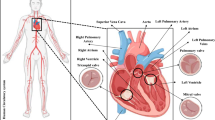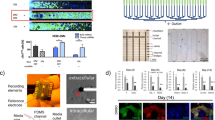Abstract
The zebrafish (Danio rerio) is an emerging model for cardiovascular research. The zebrafish heart regenerates after 20% ventricular amputation. However, assessment of the physiological responses during heart regeneration has been hampered by the small size of the heart and the necessity of conducting experiments in an aqueous environment. We developed a methodology to monitor a real-time surface electrocardiogram (ECG) by the use of micro-electrodes, signal amplification, and a low pass-filter at a sampling rate of 1 kHz. Wavelet transform was used to further remove ambient noises. Rather than paralyzing the fish, we performed mild sedation by placing the fish in a water bath mixed with MS-222 (tricane methanesulfonate). We recorded distinct P waves for atrial contraction, QRS complexes for ventricular depolarization, and QT intervals for ventricular repolarization prior to, and 2 and 4 days post-amputation (dpa). Sedation reduced the mean fish heart rate from 149 ± 18 to 90 ± 17 beats/min. The PR and QRS intervals remained unchanged in response to ventricular apical amputation (n = 6, p > 0.05). Corrected QT intervals (QTc) were shortened 4 dpa (n = 6, p < 0.05). In a parallel study, histology revealed that apical thrombi were replaced with fibrin clots and collagen fibers. Atrial arrhythmia was noted in response to prolonged sedation. Unlike the human counterpart, ventricular tachycardia or fibrillation was not observed in response to ventricular amputation 2 and 4 dpa. Taken together, we demonstrated a minimally invasive methodology to monitor zebrafish heart function, electrical activities, and regeneration in real-time.







Similar content being viewed by others
References
R. Arnaout, T. Ferrer, J. Huisken, K. Spitzer, D. Y. Stainier, M. Tristani-Firouzi, and N. C. Chi, “Zebrafish model for human long QT syndrome,” Proc Natl Acad Sci U S A, vol. 104, pp. 11316-21, Jul 3 2007. doi:10.1073/pnas.0702724104
R. O. Becker, S. Chapin, and R. Sherry, “Regeneration of the ventricular myocardium in amphibians,” Nature, vol. 248, pp. 145-7, Mar 8 1974. doi:10.1038/248145a0
E. Braunwald, D. P. Zipes, P. Libby, and R. Bonow, Braunwald’s Heart Disease: A Textbook of Cardiovascular Medicine, 7th ed. Philadelphia: Saunders Company, 2004.
E. E. Braunwald, D. P. E. Zipes, P. E. Libby, and R. E. Bonow, “Braunwald’s Heart Disease: A Textbook of Cardiovascular Medicine,” 5 edition ed Philadelphia: Saunders Company, 2004, p. 114.
C. S. Burrus, R. A. Gopinath, and H. Guo, Introduction to Wavelets and Wavelet Transforms: A Primer. Upper Saddle River, NJ: Prentice-Hall, 1997.
I. Daubechies, Ten Lectures on Wavelets. Philadelphia, PA: Soc. Indus. Appl. Math., 1992.
D. L. Donoho 1995 “De-noising by soft-thresholding,” IEEE Trans. Inform. Theory 41:613-627. doi:10.1109/18.382009
A. S. Forouhar, A. Hickerson, M. Liebling, A. Moghaddam, J. Lu, H.-J. Tsai, J. R. Hove, S. E. Fraser, M. Dickinson, and M. Gharib, “The embryonic vertebrate heart tube is a dynamic suction pump,” Science, vol. 312, pp. 751-753, 2006. doi:10.1126/science.1123775
A. S. Forouhar, J. R. Hove, C. Calvert, J. Flores, H. Jadvar, and M. Gharib, “Electrocardiographic characterization of embryonic zebrafish,” Conf Proc IEEE Eng Med Biol Soc, vol. 5, pp. 3615-7, 2004.
Glantz, S. A. Primer of Biostatistics, 6th ed. McGraw-Hill, pp. 386–388, 2005.
Hahn, C., and M. A. Schuwartz. The role of cellular adaptation to mechanical forces in atherosclerosis. Arterioscler. Thromb. Vasc. Biol. 28:2101–2107, 2008. doi:10.1161/ATVBAHA.108.165951
Hove, J. R., R. W. Köster, A. S. Forouhar, G. Acevedo-Bolton, S. E. Fraser, and M. Gharib. Intracardiac fluid-forces are an essential epigenetic factor for embryonic cardiogenesis. Nature 421:172–177, 2003. doi:10.1038/nature01282
D. J. Milan, I. L. Jones, P. T. Ellinor, and C. A. MacRae, “In vivo recording of adult zebrafish electrocardiogram and assessment of drug-induced QT prolongation,” Am J Physiol Heart Circ Physiol, vol. 291, pp. H269-73, Jul 2006. doi:10.1152/ajpheart.00960.2005
D. J. Milan and C. A. MacRae, “Animal models for arrhythmias,” Cardiovasc Res, vol. 67, pp. 426-37, Aug 15 2005. doi:10.1016/j.cardiores.2005.06.012
Nusslein-Volhard, C., and R. Dahm (Editors), Zebrafish. New York: Oxford University Press, 2002.
J. O. Oberpriller and J. C. Oberpriller, “Response of the adult newt ventricle to injury,” J Exp Zool, vol. 187, pp. 249-53, Feb 1974. doi:10.1002/jez.1401870208
K. D. Poss, L. G. Wilson, and M. T. Keating, “Heart regeneration in zebrafish,” Science, vol. 298, pp. 2188-90, Dec 13 2002. doi:10.1126/science.1077857
A. Raya, A. Consiglio, Y. Kawakami, C. Rodriguez-Esteban, and J. C. Izpisua-Belmonte, “The zebrafish as a model of heart regeneration,” Cloning Stem Cells, vol. 6, pp. 345–51, 2004. doi:10.1089/clo.2004.6.345
J. L. Reeve, A. M. Duffy, T. O’Brien, and A. Samali, “Don’t lose heart–therapeutic value of apoptosis prevention in the treatment of cardiovascular disease.,” J Cell Mol Med., vol. 9, pp. 609-22, 2005. doi:10.1111/j.1582-4934.2005.tb00492.x
D. Sedmera, M. Reckova, A. deAlmeida, M. Sedmerova, M. Biermann, J. Volejnik, A. Sarre, E. Raddatz, R. A. McCarthy, R. G. Gourdie, and R. P. Thompson, “Functional and morphological evidence for a ventricular conduction system in zebrafish and Xenopus hearts,” Am J Physiol Heart Circ Physiol, vol. 284, pp. H1152-60, Apr 2003.
D. Y. Stainier, “Zebrafish genetics and vertebrate heart formation,” Nat Rev Genet, vol. 2, pp. 39-48, Jan 2001. doi:10.1038/35047564
Szilagyi, S. M., and L. Szilagyi. Wavelet transform and neural-network-based adaptive filtering for QRS detection. In: Proceedings of the 22nd Annual International Conference of the IEEE, Vol. 2, 2000, pp. 1267–1270.
Acknowledgments
The authors would like to express gratitude to Calum MacRae from Massachusetts General Hospital, Harvard Medical School for his advice on zebrafish ECG measurement. This project was supported by USC Zumberge Interdisciplinary Research Award (TKH), and NHLB 083015 (TKA), NHLBI 068689 (TKH), and AHA GIA 0655051Y (TKH), AHA Science Development Award (CLL).
Author information
Authors and Affiliations
Corresponding author
Additional information
P. Sun, Y. Zhang, and F. Yu contributed equally to this work.
Rights and permissions
About this article
Cite this article
Sun, P., Zhang, Y., Yu, F. et al. Micro-Electrocardiograms to Study Post-Ventricular Amputation of Zebrafish Heart. Ann Biomed Eng 37, 890–901 (2009). https://doi.org/10.1007/s10439-009-9668-3
Received:
Accepted:
Published:
Issue Date:
DOI: https://doi.org/10.1007/s10439-009-9668-3




